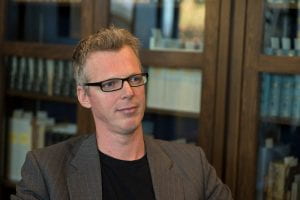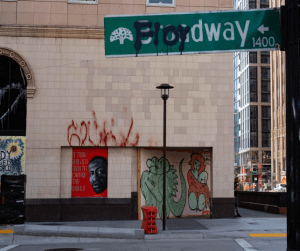The Center for Research, Artistic, and Scholarly Excellence (CRASE) had the immense pleasure to host celebrated novelist Tommy Orange over three separate events held over Zoom on April 19, 2021.
In the first session, Tommy Orange spoke to a select group of about 15 students from the English Department, the School of Education, and the MFA in Creative Writing program. All the students attending had read There There and had the chance to pose questions they had wondered about in class directly to the author, which is a rare opportunity. Topics ranged from the potential pitfalls of writing autobiographical fiction, the challenges of experimental writing, the importance of indigenous literature, strategies for building characters, and even the thorny ethical dilemmas that can come when one writes about people who are still alive (and just so happen to be members of your family).
Students had great questions about the use of perspective and point of view in the novel, such as the use of second person in one of the chapters. Tommy Orange gave us great insight as to how this is part of his creative process, and how he plays with perspective to see “what it will do” to the story. Additionally, he gave us insight into how much of the story is based on his own experiences, woven into these characters, invoking the concept of “auto-fiction.” These ideas really stuck with students and, again, the opportunity to engage a writer directly with their thoughts, observations, and inquiries was a wonderful way to develop their academic experience! Tommy Orange responded with both thoughtfulness and graciousness. The students asked smart question, and he responded in kind. The event was a great success.
During the second event, Tommy Orange met with faculty to discuss the pieces they wrote in response to his book. Faculty responses, which were published in the Journal of Interdisciplinary Perspectives and Scholarship, reflected on place and identity in a modern world. Each faculty who wrote a response explained their piece to Tommy Orange and how the book inspired their work. The conversation between Tommy Orange and the faculty responders evolved into a dialogue related to his thoughts on the response pieces and next steps for his writing.
When asked about how Native Americans can bridge the dichotomy between tradition and modernity—a theme he addresses in his book—Tommy Orange said that one of the challenges he liked to take up in his writing was giving voice to Native Americans in the present, because they are always otherwise spoken of in terms of the past, relegated to history as it were. He brought up the arguments made in David Treuer’s excellent essay that make a persuasive case for returning America’s national parks to its original peoples. In addressing the experience of visiting national parks and the question of representing Native Americans in the present, Treuer writes, “Indians were barely mentioned on the signage, and I don’t remember meeting any Native rangers or even sensing that we existed as anything other than America’s past tense.”
In the final session attended by over 160 people, Tommy Orange was in conversation with Laleh Khadivi, novelist and Assistant Professor of Creative Writing at USF. In this wonderful, wide-ranging conversation they spoke about the writing process, the genre of auto-fiction (writing that is close to memoir but not quite memoir), literary influences, and Tommy Orange’s second book, among other topics. Tommy Orange read from There There, a section titled “Apparent Death,” and spoke about how his own graphic dreams had informed the depiction of a mass shooting. While his reading struck a somber note—“….the fact that we’ve been fighting for decades to be recognized as a present-tense people, modern and relevant, alive, only to die in the grass wearing feathers”—it was extremely relevant in the context of ubiquitous gun violence, and the here and now of Native Americans in the country.
(With contributions from Erin Grinshteyn, Christina Garcia Lopez, Dean Rader and Tanu Sankalia)
 USF Associate Professor of Philosophy,
USF Associate Professor of Philosophy, 